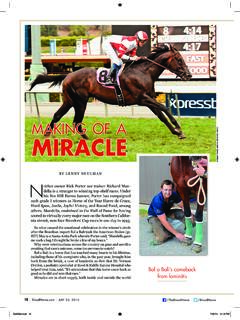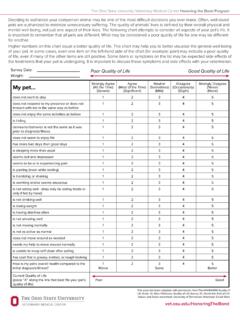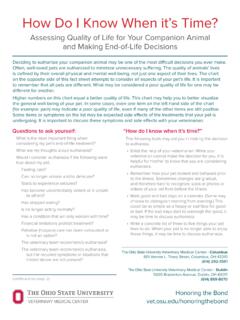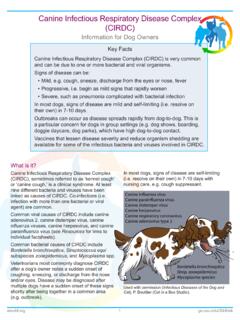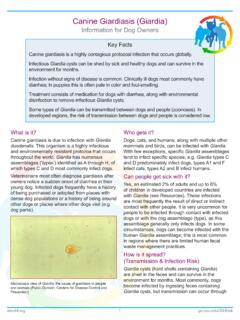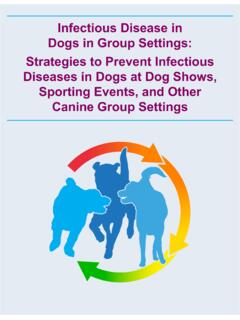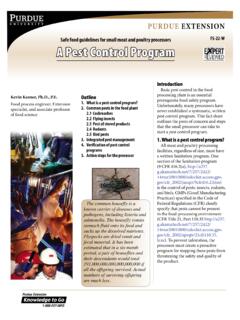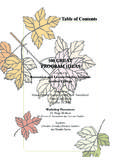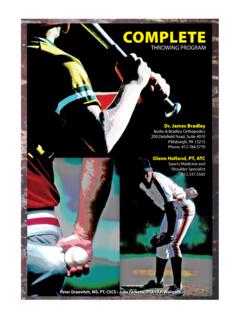Transcription of Canine Parvovirus Fact Sheet - Home | College of ...
1 1 Canine Parvovirus Information for Dog OwnersKey FactsCanine Parvovirus is a very contagious viral infection that occurs typically affects unvaccinated puppies (< 6 months of age) but can occur in unvaccinated dogs of any signs often include depression, not eating, vomiting and profuse diarrhea which is often blood tinged. Severe disease can result in and subsequent treatment need to be initiated immediately; mortality is high and prognosis worsens as dogs develop more severe is highly effective at protecting against Parvovirus . The virus is extremely hardy; contaminated environments can remain a source of infection for is it?
2 Canine Parvovirus (CPV) is a highly infectious and environmentally resistant virus that occurs throughout the world. Veterinarians most often diagnose infection after owners bring their dog (usually a puppy) to be examined because they are suddenly very sick ( not eating, vomiting, not wanting to run or play, severe diarrhea). Infected dogs are typically unvaccinated or incompletely vaccinated (have not received their entire puppy series) and have a history of being around other dogs or places where other dogs visit ( dog parks).The virus usually enters the dog through sniffing or eating infected feces or direct contact with an infected dog.
3 Dogs can shed the virus before they show signs of illness and for several weeks after disease has resolved. Therefore, even dogs that appear healthy can transmit Parvovirus . The virus is very hardy - it can remain active in the environment for months ( on soil, cages, toys) and serve as a continued source of gets it?Domestic and wild dogs can be infected with Canine Parvovirus . Puppies are most susceptible after passive immunity from their dam wanes and when they are breeds and types of dogs appear to have a higher risk of Parvovirus infection or show more severe illness once infected. These include Rottweilers, Doberman Pinschers, Labrador Retrievers, German Shepherds, Bull Terrier breeds, and Alaskan sled dogs.
4 2 Can people get sick with it?No, infection with Canine Parvovirus has not been documented in people. However, people can spread it to other dogs if they have the virus on their hands or clothing and then touch other dogs or their environment ( kennel, toys, grooming tools).How is it spread? (Transmission & Infection risk) Canine Parvovirus is usually spread to a dog after the virus enters the dog s mouth, spreads to the lymph and blood vessels and then moves throughout the body. It can take between 4 to 14 days for disease to develop after infection. The virus attacks the cells of the dog s bone marrow and the intestine.
5 Infected dogs generally become severely immunosuppressed, allowing other bacteria, viruses and parasites to proliferate and worsen disease. Infected dogs develop profuse, often bloody, Parvovirus is spread by direct contact with an infected dog or sniffing or eating infected feces. Infection can also spread through contact with items contaminated with the virus, such as shared bedding, bowls, soil, or even people s hands or clothing, and in this way the virus can be passed from one dog to another. Washing hands thoroughly with soap and water will remove the virus. Specific disinfectants need to be used to remove Parvovirus from the environment, including toys, clothing and cages.
6 See the Resources section below for a list of disinfectants effective against Parvovirus note it is a nonenveloped virus. What should I look for? (Signs of disease)Signs of disease include acute (rapid onset) vomiting, diarrhea or lethargy (acting very tired and weak). Fever can occur; however, some dogs may have a low (subnormal) temperature and concurrent shock (inadequate blood flow to the body, resulting in organ damage) due to severe dehydration. Rarely, sudden death due to heart disease can occur in very young puppies (neonates). Dogs that survive Parvovirus infection may have an increased risk for developing chronic gastrointestinal disease later in is it diagnosed?
7 Your veterinarian will diagnose Parvovirus based on history ( unvaccinated, recent dog-to-dog contact), clinical signs (vomiting, diarrhea) and examination findings. A specific and rapid in-clinic ELISA test for Parvovirus performed on fecal material is most commonly used to confirm infection. If your puppy has an acute onset of vomiting or diarrhea and has not been vaccinated or received its entire puppy series of vaccines, your veterinarian may ask you to keep your puppy in a safe place outside the clinic ( with you in your car) until they can evaluate your dog and perform a Parvovirus test. This is done to determine the chance your dog has Parvovirus , and consequently steps that will be taken to prevent spread of the virus into the veterinary clinic, where other dogs may be exposed and become veterinarian may perform additional blood tests ( , complete blood count, serum biochemistry) to determine the degree of immune suppression (low white blood cell counts), anemia and low protein levels.
8 These tests help with prognosis and treatment planning. A fecal examination may be advised to help identify and treat parasites that can worsen vaccination can make interpretation of the Parvovirus ELISA test challenging it is important to let your veterinarian know if and when your dog was vaccinated against is the treatment? Will my dog recover? Treatment consists of fluid therapy to correct dehydration and losses due to vomiting and diarrhea. Antibiotics are frequently used to treat and prevent infections that occur secondary to immunosuppression. Medications to reduce vomiting, nausea and pain are also helpful.
9 Nutritional support is critical and speeds recovery. Some dogs may require hospitalization and intravenous treatments. Dogs with severe disease will need advanced care at an intensive care facility where they can receive careful monitoring. Dogs with mild illness may be managed at home under the guidance of a veterinarian. Prognosis (recovery) is good with prompt and aggressive therapy. However, whether your dog improves will depend on 1) how quickly he/she is diagnosed and treated, 2) response to treatment, and 3) in severe illness whether referral to an intensive care facility is an option. Testing and subsequent treatment need to be initiated immediately; prognosis worsens as dogs develop more severe can I stop this from happening to my dog and other dogs?
10 Be informed and proactive. Recovered dogs can shed Parvovirus for up to 2 weeks after illness. It is best to keep your dog away from dogs who have been recently infected with Parvovirus . Vaccinate puppies to prevent infection with Parvovirus - this is especially important for puppies that will have a high level of dog-to-dog contact, puppy classes or dog shows. Parvovirus is a recommended core vaccine for all dogs. In general, vaccination should begin at 6 - 8 weeks of age and be repeated at 3 - 4 week intervals until puppies are 16 weeks of age. Boosters at one year of age and then every 3 years are advised to maintain immunity throughout adulthood.
